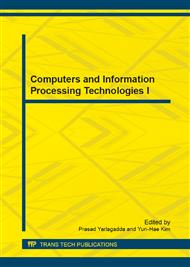[1]
Ozment A. Vulnerability discovery & software security[J]. University of Cambridge Computer Laboratory Computer Security Group &Magdalene College, (2007).
Google Scholar
[2]
Liu B, Shi L, Cai Z, et al. Software vulnerability discovery techniques: A survey[C]/Multimedia Information Networking and Security (MINES), 2012 Fourth International Conference on. IEEE, 2012: 152-156.
DOI: 10.1109/mines.2012.202
Google Scholar
[3]
Sutton M, Greene A, Amini P. Fuzzing: brute force vulnerability discovery[M]. Pearson Education, (2007).
Google Scholar
[4]
Godefroid P, Levin M Y, Molnar D. Sage: Whitebox fuzzing for security testing[J]. Queue, 2012, 10(1): 20.
DOI: 10.1145/2090147.2094081
Google Scholar
[5]
Bekrar S, Bekrar C, Groz R, et al. Finding software vulnerabilities by smart fuzzing[C]/Software Testing, Verification and Validation (ICST), 2011 IEEE Fourth International Conference on. IEEE, 2011: 427-430.
DOI: 10.1109/icst.2011.48
Google Scholar
[6]
Kaner C, Bond W P. Software engineering metrics: What do they measure and how do we know [J]. Methodology, 2004, 8: 6.
Google Scholar
[7]
Schwartz E J, Avgerinos T, Brumley D. All you ever wanted to know about dynamic taint analysis and forward symbolic execution [C]. Security and Privacy (SP), 2010 IEEE Symposium on. IEEE, 2010: 317-331.
DOI: 10.1109/sp.2010.26
Google Scholar
[8]
Lin Z, Jiang X, Xu D, et al. Automatic Protocol Format Reverse Engineering through Context-Aware Monitored Execution[C]. NDSS. 2008, 8: 1-15.
Google Scholar
[9]
Lin Z, Zhang X, Xu D. Reverse engineering input syntactic structure from program execution and its applications [J]. Software Engineering, IEEE Transactions on, 2010, 36(5): 688-703.
DOI: 10.1109/tse.2009.54
Google Scholar
[10]
Caballero J, Yin H, Liang Z, et al. Polyglot: Automatic extraction of protocol message format using dynamic binary analysis[C]. Proceedings of the 14th ACM conference on Computer and communications security. ACM, 2007: 317-329.
DOI: 10.1145/1315245.1315286
Google Scholar
[11]
Song D, Brumley D, Yin H, et al. BitBlaze: Binary Analysis for Computer Security[J]. (2013).
Google Scholar
[12]
Antiparser: http: /antiparser. sourceforge. net.
Google Scholar
[13]
Amini P. PaiMei-Reverse Engineering Framework[C]/Reverse Engineering Conference, (RECON). (2006).
Google Scholar


